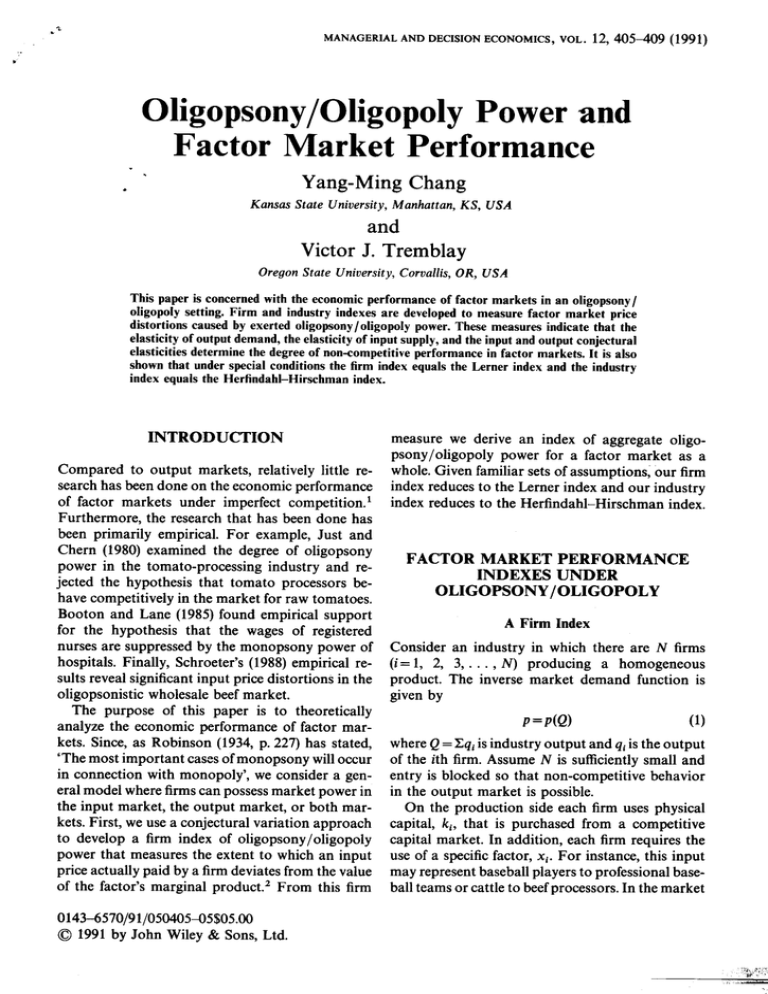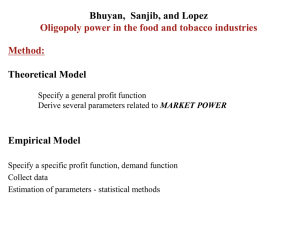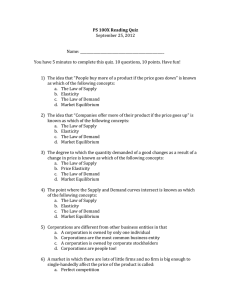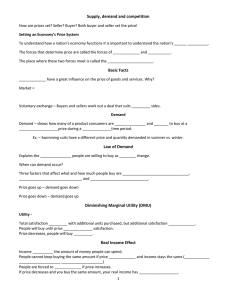. Oligopsony jOligopoly Power and Factor Market Performance
advertisement

.
'"
.MANAGERIAL
AND DECISION
ECONOMICS,
VOL. 12, 405-409 (1991)
Oligopsony jOligopoly Power and
Factor Market Performance
.'
Yang-Ming
Chang
Kansas State University, Manhattan, KS, USA
and
Victor
Jo Tremblay
Oregon State University, Corvallis, OR, USA
This paperis concernedwith the economicperformanceof factor markets in an oligopsony/
oligopoly setting. Firm and industry indexesare developedto measurefactor market price
distortions causedby exerted oligopsony/ oligopoly power. Thesemeasuresindicate that the
elasticity of output demand,the elasticity of input supply,and the input and output conjectural
elasticitiesdeterminethe degreeof non-competitiveperformancein factor markets. It is also
shownthat under specialconditionsthe firm index equalsthe Lerner index and the industry
index equalsthe Herfindahl-Hirschman index.
INTRODUCTION
Compared to output markets, relatively little research has been done on the economic performance
of factor markets under imperfect competition.!
Furthermore, the research that has been done has
been primarily empirical. For example, Just and
Chern ~1980) examined the ~egr:e of oligopsony
power In the tomato-processIng Industry and rejected the hypothesis that tomato processors behave competitively in the market for raw tomatoes.
Booton and Lane (1985) found empirical support
for the hypothesis that the wages of registered
nurses are suppressed by the monopsony power of
hospitals. Finally, Schroeter's (1988) empirical resuIts reveal significant input price distortions in the
oligopsonistic wholesale beef market.
The purpose of ~his paper is to theoretically
analyze the economIc performance of factor markets. Since, as Robinson (1934, p.227) has stated,
'The most important casesof monopsony will occur
in connection with monopoly', we consider a general model where firms can possessmarket power in
the input market, the output market, or both markets. First, we use a conjectural variation approach
to develop a firm index of oligopsony/oligopoly
power that measures the extent to which an input
price actually paid by a firm deviates from the value
of the factor's marginal product.2 From this firm
measure we derive an index of aggregate oligopsony / oligopoly power for a factor market as a
whole. Given familiar sets of assumptions, our firm
index reduces to the Lerner index and our industry
index reduces to the Herfindahl-Hirschman index.
FACTOR
MARKET
INDEXES
OLIGOPSONY
PERFORMANCE
UNDER
jOLIGOPOL
Y
A Form Ind x
I
e
Consider an industry in which there are N firms
(i = 1, 2, 3,...,
N) producing a homogeneous
product. The inverse market demand function is
given by
p=p(Q)
(1)
where Q = ~qi is industry output and qi is the output
of the ith firm. Assume N is sufficiently small and
entry is blocked so that non-competitive behavior
in the output market is possible.
On the production side each firm uses physical
capital, ki, that is purchased from a competitive
capital market. In addition, each firm requires the
use of a specific factor, Xi' For instance, this input
may represent baseball players to professional baseball teams or cattle to beef processors. In the market
0143-6570/91/050405-05$05.00
~ 1991 by John Wiley & Sons, Ltd.
""-!,~,~;
406
¥.-M. CHANG AND V. J. TREMBLA¥
for the specific factor, however, non-competitive
buyer behavior is possible,3 In this case, the inverse
market supply of the specific factor is given by
w = h(X)
(2)
x
d
I
I
f h
'fi l"
, h
IS t e tota supp y 0 t e specI c lactor an
h
"
f X F
h
d /dX '
h
were
.
W IS t de per beUnIt
assume
to
ffi
'
su
Pi==(dX/dxi)(Xi/X),
the ith firm's input conjectural
elasticity
with
respect
to
the
industry's total factor demand,
I
II
clent
,
y
f
f
price
.,0
h
t
price
' ,
sma
t
.urt
N
'
d
an
h
so
h
at
er '
W
d
IS assume
fi
'
eac
rm
can
IS
be
h
uence
t
'
dIrectly
reflects
allocatlve "
the
,
InefficIency
due
to
market
power
by
measuring
,
the
non-competItIve
e,
IS
,
acquIred
va I ue
0 f th e
by the
margma '
'
qi = .fi(Xi' kJ
be-
"
fl
m
for non-competitive
havior in both the factor and output markets, it will
'"
be referred to as an oligopsony/oligopoly
Index. It
to
F '
II
h
' h fi
'
d
.rents
ma
y, t e It
rm s pro
uctlon
.~
IS lactor.
unctIon
0
posItIve,
Because this index allows
(3)
firm
as a proportIon
I pro d uc. t
It comes
of the
as no
,
surprise that the Index has two components:
(Pi/e)
reflects the non-competitive
performance
in the
d
b
' I
d
'
d '
an IS assume to e strict y concave an contIn,
..perlormance
uously tWIce dIfferentIable.
.'
The problem of the Ith firm then IS to choose Xi
,
, ,
,
and ki m order to maxImIze the firm s profit func.,
b
tIon given y
input market and (lXi/") reflects the non-competitive
l"
'
m th e ou t pu t mar k e,t
Because p (MP X; ) :::,W:::" 0 th e vaueI
0 f 1; can
f
0 t 1 Wh
th
.fi l" t '
.
range rom
0,
en
e SpeCI c lac or IS pal d
th
I
f 't
' I
d t th t '
e va ue 0 I S margma
pro uc,
a IS, W
= p(M Px;), the factor market is allocatively efficient
1ti=p(Q)q;-h(X)xi-rki
(4)
'
fi
d
' h
I
' h ' h fi
1t.
IS, t e It
rm s pro ts an r IS t e renta
,
, ,
and 1;=0; as the factor price is reduced and approaches 0, ceteris paribus, I; approaches 1. Thus,
,.".
,
greater
IneffiCIency
IS Implied
by a hIgher
value
of Ii'
G'
th t
d P
't '
th
I'
Iven
a lXi an
i are pOSI Ive,
e 0 Igopsony /
oligopoly index indicates that there will be greater
(3)
wIth
e va ue
0
d ' .d d
t e marglna
b
h
I
pro
f
1 i ==[P(MPXi)-
w]/[P(MPXi)]
1
=(Pi/e+lXi/'1)/(
+pi/e)
(6)
where
fi
h
'
h
f
l"
perfectly
competItIve
to
collusIve).
lXi==(dQ/dq;)(qi/Q),
conjectural
(or
respect to total
e==(dX /dw)(w/ X),
market supply
the
ith firm's
output
perceived) elasticity with
industry output,S
the input price elasticity of
for the specific factor,
For
'
.
m
example,
' ..
the case of Cournot behavIor m both the Input and
OUt pu t mar k e t s, dX/d XI,= 1 an d dQ/d q".= 1 6 A s a
It P
th '
resu , i IS e mpu t mar k e t sh are an d lXi th e ou t pu t
market share of the ith firm.
.
Alternatively,
consider
the special
situation
where the output market is competitive
and the
specific factor market is imperfectly competitive, In
this case lXi=O (because dQ/dqi=O)
and O<Pi~ 1.
The firm index derived from Eqn (6) then reduces to
th l" II .
I'
/
t 't "
'
fi
,
,
MPXi==aqi/aXi,
the margInal product of the mustry-specl c lactor 0 tel t
rm,
,,== -(dQ/dp)(P/Q),
the price elasticity of demand in the output market,
d
t
-.,.
h
IOjc=pi/(e+PJ
)
'
uct an t e Input price
IVI e
y t e va ue 0 t e
' I
' d
' d ' d
d d 4., Th e It' h fi( rms' h m
margma
erlve
f
E pro
( ) uct.
A ex IS .l"
rom
qn 5a an IS gIven as see t e ppendlx lor a
f)
proo
ojc:
t
'
higher the firm's conjectural elasticity with respect
to industry demand for the specific factor (PJ.
This oligopsony/oligopoly
index is quite general
t ' t'
SInce no res rIC Ions are p ace on
e conJec ura
., ..
elastIcItIes of the firm (I.e. they may range from
ex
tween
h
elasticity
(4) the
(I
erence
d
and
d
I
'
fi
h
+p(aqi/ak;)-r=O
(5b)
,
,.,
To measure Input price dls~ortlons we concentrate on the market for the speCIfic factor. We define,
d
f ..
d"
h
term
m ex 0 Input price
Istortlons
as t e
be
h
I
f h
' I
d
d ' fli
the
highe~
the
firm's
conjectural
respect
to
Industry
output
(IXJ,
I
.(e~,
,q,
th
/ak,)
qi
m
.)(a
q,
inefficiency, ceteris paribus, (1) the lower the price
~Iasticit~ of dem~~d for output (,,), (2) the ~ower the
Input price elastICIty of supply of the speCIfic factor
Ion
/dQ)(dQ/d
p
(5a)
I
(d
p(aqi/aXJ
/dx.)x.-w=O
, ,
I
(dp/dQ)(dQ/dqJ(aqi/aX;)qi+
-(dw/dX)(dX
d
condItIons
compe
necessary
Igopsony
first-order
0
The
oWIng
of capItal.
10
rate
are:
e
h
were
(7)
In pure monopsony where there is just one input
buyer, Xi=X and therefore P;= 1. In this case the
index equals 1/(e+ 1). When both the output market and the input market are competitive, lXi= p;=O
MARKET POWERAND PERFORMANCE
and the index equals 0 (indicating that the factor
market
In the
is operating
case
I~/o=1:{[P(MPx;)-w]/[P(MPxi)]}Sqi
efficiently).
of market
= 1:v.
power
in the
output
market
S
,(
alone, O«Xi~ 1 and Pi=O. In this competition/
oligopoly setting the index (I c/o)becomes
I -/
(8)
c/o-(Xi "
407
.2
12
q,)
(
)
where vi=(dQ/dq;)/" and Sqi=qi/Q (the output
market share of firm i). When all firms have constant and identical conjectural variations, then Viis
the same for all firms and the industry index is
Finally, lhere is the classic caseof monopsony/proportional to the Herfindahl-Hirschman index of
monopoly suggestedby Robinsonwhere Pi= 1 for a the output market [1:(Sqif]. If Vi= 1, then the
monopsonist (because Xi= X) and (Xi= 1 for a industry index equals the output market
monopolist (becauseqi = Q). In this situation the Herfindahl-Hirschman index.
monopsony/monopoly index (Im/m)equals
I m/m= (1 /8+1 / "" )/( 1+1 / 8 )
Index Implementation
.
(9)
Although Lerner (1943, pp. 210-11) initially dis- A .
f h.. d .
n Important use0 t IS
cussesb0th monopo Iy and monopsony power, he.
.,m ex ISto assesst he degree
It ' t I tt
t
'
t
fi
d
th
t
f
of
oligopsony
and
oligopoly
power m a factor
U Ima e y a emp son
e amoun
0 mono,
.
'
po Iy revenue, , ,so th at th ere was no monopsony,
I n Lerner's case 0f pure monopoIy ((Xi= 1) WI' th no
monopsony
power
(a
I'i
0)
=
th
'
e
m
d
.
ex
E
m
(9)
qn.
market.
II
ThIs can be accomplished,
for example,
the
followIng
production,
output
market
,
d
t th
II k
L
' d
1/
re uces 0 e we -nown erner m ex, ".
by
. the appropnate
. data and first estimating
...
co ectlng
..
demand,
9
and Input market supply functions:
qi=/;(Xi' Zl)
(13)
An Industry Index
p=p(Q, Z2)
(14)
Next, an index of oligopsony/oligopoly power for
the specific factor market as a whole (1*) is developed, This aggregate index, which is derived
from Eqn (6),is defined as
w=h(X, Z3)
(15)
1*=1: {[p(MPx;)-w]/[p(MPxi)]}Sxi=1:IiSxi
(10)
where SXi= Xii X (the input market shareof firm i),
ThIs Industry
measureISa weIghtedaverageof each.
..
'
firm's Index of power WIth Input
shares used l'lor
.
welg hts.
In the caseof oligopsony/ competition and given
the definition of Pi' the industry index becomes
I:/c = 1:Ui(SX;)2
(11)
where Zl, Z2, and Z3 are vectors of relevant
exogenousvariables,lOThese empirical results can
then be used to produce estimatesof the marginal
product of input X (Oqi/OXi)'the slopeof the demand
function in the output market (op/oQ), and the
slope of the supply function in the factor market
(ow
G/.OX)'th t.
Iven e es Imated vaIuesfrom above and defi n'
(Q/ ) d (J =.
- P"(X/ X.), the l'10II owIn
mg (J2=(X.
". q.an
. g
3
rearranged
versIon of Eqn (Sa)can then be estlmt d'
ae .
W=(Jl [P(Oqi/OXi)]+ (J2[(op/oQ)
X (Oqi/OX;)Q;]-(J3[(OW/OX)Xi]
(16)
where Ui= (dX/dxi)/(8 +Pi)' If the input conjectural
variations are constant and the same for all firms,
then Ui is identical for all firms and the industry
indexis proportional to the Herfindahl-Hirschman
index of the input market [1:(SXif], 7 In the special
where (Jl, (J2,and (J3are unknown parameters.ll
Because(Xi= (J2(qi/Q)and Pi=(J3(Xi/X), the degree
of oligopsonyand oligopoly price distortions canbe
determined.For example,the hypothesis that input
price distortions are presentis rejectedif (Jl= 1 and
case where Ui= 1, the industry index equals the
input market Herfindahl-Hirschman index,8
Finally, when the focus is on output market
power as in a competition/oligopoly setting,it may
be convenientto changethe weights from input to
output market shares and define the industry
index as
(J2=(J3=0.This result indicates that the market is
operating efficiently becausethe factor price equals
the value of the marginal product. Significantpositive values of (J2and (J3indicate the presenceof
oligopoly and oligopsofly power, respectively.Finally, the degreeof input price distortion at the firm
level canbe calculated by inserting the data into the
-""'"'C",
-"","""c:
,.~.~"'""~
:..
408
Y.-M.CHANGANDV.J. TREMBLAY
index in Eqn (6). This information, along with the
data on firm market share, ca~ also b~ us~d to
calculate the degree of average mput pnce dIstortion at the industry level from Eqn (10).
equality in Eqn (A4) gives
[p(MPxj)]/[p(MPxJ]
-w/[p(MPxJ]
= 1-(I-tXj/,,)/(1
+ (pj/e»
(A5)
Simplification and rearranging terms yields
CONCLUSIONS
[p(MPxJ-w]/[p(MPxJ]
..=
ThIS paper draws on the theory of olIgopsony and
oligopoly to analyze factor market distortions
caused by market power in the input market, the
output market, or both markets. Indexes capable of
measuring exerted oligopsony I oligopoly power at
the firm and industry levels are developed, and
em p irical
implementation
of
the
indexes
is
dis-
cussed. These measures mdIcate that the elastIcIty
of output demand, the elasticity of input supply,
and the input and output conjectural elasticities
determine the degree of non-competitive performance in factor markets. It is also shown that
under special conditions the firm oligopsony I oligopoly index is identical to the Lerner index and the
industry oligopsony loligopoly index is identical to
the Herfindahl-Hirschman
index.
APPENDIX
A formal derivation of Eqn (6) is as follows. First
Eqn (5a) can be rearranged
,
as
I )] [( d Qld )( IQ)] [P(o l ox )]
[( d pi d Q)(Q p
qj qj
qj
I
+ [p(oqj/oXj)] = [(dw/dX)(Xlw)]
x [(dXldxJ(xj/X)]w+w
(AI)
..psony
Factonng out p(oqjl oxJ from the left-hand sIde and
w from the right-hand side of the equality in
Eqh (AI) gives
p(oqj/oxJ{l
+ [(dpldQ)(Qlp)]
[(dQldqJ
x (qj/Q)]}
=w{1 + [(dw/dX)(X
Iw)]
x [(dX IdxJ(xjl X)]}
(A2)
b ..
h d fi ..
f
h
By su stItutIng t.e
e mtIons rom t e text,
Eqn (A2) can be wntten as
I ) -W (1 + P I e)
(A3 )
p (M P Xj)( 1- tXj " -j
which implies that
w/[p(MPxJ]=(I-tXj/")/(I+pj/e)
(A4)
Multiplying both sides of the equality by -1 and
adding [p(MPxJ]/[p(MPxi)]
to both sides of the
(pj/e + tXj/,,)/(1 + Pile)
which is Eqn (6).
(A6)
QED
Acknowledgements
The authors would like to thank David G. Hula, Joe R.
Kerkvliet, James F. Ragan, Jr, Carol Horton Tremblay and an
anonymous referee for helpful comments. The authors are
responsible
for all remainingerrors.
NOTES
1. SeeSchererand Ross (1990)for a surveyand Dansby
and Willig (1979), Appelbaum (1982), Kamien and
S.chwar~z(1983),and Dau~~ety (1985)for a discusslon of Imperfectly competitive output markets.
2. Although Schroeterdevelopeda measure of monopsony power, it applies only to the specialcasewhere
the production technology is characterized by fixed
proportions betweenthe quantity of output (dressed
beefcarcassesin his study) and the quantity of the
monopsonistically demanded input (live beef).
3. Input market sellers are assumed to have no market
power. This assumption is certainly realistic for many
raw materials suppliers (e.g. tomato farmers and
cattle ranchers),but even the monopsony power in
labor .markets ~~s not always generated effective
collective bargaining power for labor. For example,
Booton and Lane (1985, p.185) argue that monopower in nursing exists in the absence of
widespread unionization. Dworkin's (1981)account
of professional baseball in the USA indicates that
union power was, until recently, so weak that the
reserveclause (making each player the property of
one team)existed for almost 90 years before the first
collective bargaining contract.
4. This approachis similar to that developedby Lerner
(1932), who defined the index of monopoly price
distortions as the difference between the (output)
price and marginal cost divided by the price.
5. See Dickson (1981) and Appelbaum (1982) for a
discussion of conjectural elasticities with respectto
output markets.
6. Daughety (1985)has shown that the Cournot equilibrium is also a 'consistentconjectural variation' equilibrium.
7. If, for example, all firms have the same objective
function, face the same cost function, and produce a
homogeneous product, then in equilibrium their
conjectural variations must also be the same.
~ ~
MARKET POWER AND PERFORMANCE
8. If the input sharesare the samefor all firms, the input
Herfindahl-Hirschman index equals 1/ N, the same
property that holds for the output HerfindahlHirschman index when output sharesare equal.
9. Alternatively, a cost or profit function could be
estimatedand usedto derive the production function
(McFadden, 1978).
10. To estimate this system, functional forms must be
chosen, the variables in Zl' Z2' and Z3 must be
identified, and firm and market data must be obtained.
11. The bracketed terms are regressors,containing exogenous and predicted variables. See Murphy and
Topel (1985) for a method of obtaining asymptotically correct standard errors when estimating an
equation with predicted variables.
REFERENCES
E. Appelbaum (1982). The estimation of the degree of
oligopoly power. Journal ofEconometrics19, August,
287-99.
L. A. Booton and J. I. Lane (1985). Hospital market
structure and the return to nursing education. Journal
ofHuman Resources20, 2, Spring, 184-96.
K. Cowling and M. Waterson (1976).Price-costmargins
and market structure. Economica43, August, 267-74.
R. E. Dansby and R. D. Willig (1979). Industry performance gradient indexes.AmericanEconomicReview
69, 3, June,249-60.
409
A. F. Daughety(1985).ReconsideringCournot: the Cournot equilibrium is consistent. Rand Journal of Economics16, 3, Autumn, 368-79.
V. A. Dickson (1981). Conjectural variation elasticities
and concentration. EconomicsLetters 7,281-5.
J. B. Dworkin (1981).OwnersversusPlayers: Baseballand
Collective Bargaining, Boston, MA: Auburn House.
R. E. Just and W. S. Chern(1980).Tomatoes,technology,
and oligopsony. Bell Journal of Economics 11, 2,
Autumn, 584-602.
M. I. Kamien and N. I. Schwartz (1983). Conjectural
variations. CanadianJournal ofEconomics16, 2, May,
191-211.
A. P. Lerner (1971).The concept of monopoly and the
measurement of monopoly power. In Readings in
Microeconomics,2nd edn(edited by W. Breit and H. M.
Hochman), New York: Holt, Rinehart, and Winston,
pp. 207-23.
D. McFadden(1978).Cost, revenue,and profit functions.
In Production Economics: A Dual Approach to
Theory and Applications (edited by M. Fuss and D.
McFadden),Amsterdam: North-Holland.
K. M. Murphy and R. H. Topel (1985). Estimation and
inference in two-step econometric models. Journal of
Businessand EconomicStatistics3, 4, October, 370-79.
J. Robinson(1934).The Economics ofImperfect Competition, London: Macmillan.
F. M. Scherer and D. Ross (1990). Industrial Market
Structure and EconomicPerformance,3rd edn, Boston,
MA: Houghton Mifflin.
J. R. Schroeter(1988).Estimating the degree of market
power in the beef packing industry. Review of Economicsand Statistics 70, 1, February, 158-62.
-,
-~";;;~~~~





